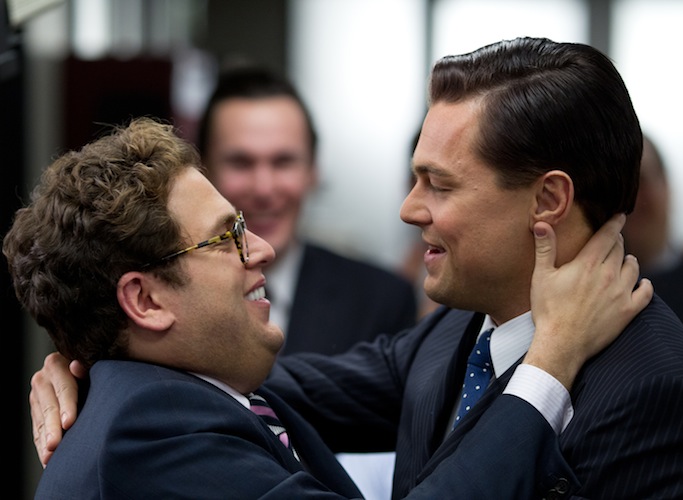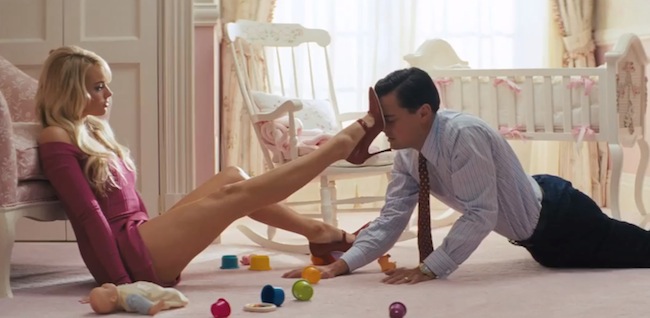Film Review: “The Wolf of Wall Street” — A Brilliant Vision of Greed Unleashed
Bravura performances are provided by all involved, making Martin Scorsese’s “The Wolf of Wall Street” quite possibly the best film of the year.
The Wolf of Wall Street, directed by Martin Scorsese. At cinemas throughout New England.

Left to right: Jonah Hill plays Danny and Leonardo DiCaprio plays Jordan Belfort in “The Wolf of Wall Street.”
By Rob Ribera
In The Wolf of Wall Street, the 71-year-old Martin Scorsese has created a film that will help define our time; a morality tale about the rapaciousness of Wall Street stockbrokers on the eve of what was repeatedly called “the worst financial crisis since the Great Depression.” Here we have an opening chapter to that cinematic history. An epic of the financial world that clocks in a near epic length, the film replaces the grand vistas of David Lean with office cubicles and slow motion shots of liquor bottles and Quaaludes. Bravura performances are provided by all involved, making this quite possibly the best film of the year. Though none of that really matters. It will be an entry point into a perverse chapter in American history as the years go by. Just as the fictional Gordon Gekko became a symbol of ’80s greed in high school history books, the all-too-real Jordan Belfort will stand in for the last twenty years of manipulation and deceit found in the bowels of Wall Street, even if the bulk of his schemes were cooked up on Long Island.
It does not matter all that much that the criminal activities the film depicts, which leads to the self-destruction of Belfort, have little to do, specifically, with those that have helped push our economy to the brink for the last decade. The Wolf of Wall Street dramatizes the pure greed, lavish lifestyles, and single-minded quest for wealth that is the core of the meltdown. It also reminds us that there are much more complicated factors at work, and that most of the 99% don’t have a clue about the inner workings of the financial system. Case in point: in one scene the camera sweeps across a bacchanalia of stockbrokers and arrives at Belfort, who breaks the fourth wall to address us. He begins to explain what an IPO is and then abruptly stops. He acknowledges that we, the audience, might be having trouble following along with the financial jargon, but assures us that all we need to know is that his illegal dealings were created to make vast sums of money in only a short amount of time. More celluloid is expended showing the drugs snorted, inhaled, inserted, and enjoyed than explaining the methods used to generate the riches that make the frolicking possible.
In fact, the best, and scariest, explanation of Wall Street comes very early on in the film, when Belfort’s new boss treats him to lunch on his first day. Thumping his chest as if he’s conquered the jungles of downtown Manhattan, the recently everywhere Matthew McConaughey explains that, as stockbrokers, they have created nothing. There is no industry, no steel or construction, only dreams and the smell of mountains of cold hard cash driving the system stoking the system. It is a grim reminder that the machinations of the worst of the financial world are based on nothing but the slick-tongued promises of more.
The Wolf of Wall Street is Scorsese’s fifth collaboration with DiCaprio, and it is their finest together. The actor gives the bravest performance of his career, and not just because he spouts obscenities throughout the film, has nude scenes with prostitutes, or snorts copious amounts of drugs off their naked bodies. It is all this, sure, but DiCaprio is a bundle of energy here, constantly boiling under the surface, then exploding over and over again in escalating cycles of avarice and self absorption the likes we have not seen from him since his role as Howard Hughes in The Aviator, another Scorsese production. DiCaprio’s Belfort is brilliant, in his own way; he is a master salesman and manipulator, a charlatan and a con-man, for sure, but he exemplifies his own niche in the American Dream. There are other moments of brilliance from Jonah Hill as Belfort’s right hand man Donnie Azoff. Scorsese has created some devastating moments in the midst of all of this decadence, a dark-as-midnight rags-to-riches story.
Obsession is the thematic anchor of the film, a major element in Scorsese’s best work. And the director is firing on all cylinders here. If nothing else, this is a master lesson in filmmaking, the editing is breathless and exciting, the music is his usual mix of rock and blues—even, finally, giving a nod to Long Island’s favorite son, Billy Joel.
The Wolf of Wall Street also contains one of the funniest sequences Scorsese has ever filmed, including both The King of Comedy and After Hours. Almost a short film in and of itself, the sequence shows Belfort traveling to a nearby country club to talk to his lawyer on a pay phone. In the conversation he learns that the FBI has bugged his house; an exorbitant amount of drugs hits his system and he collapses. The moment even gives a twisted nod to DiCaprio’s role in What’s Eating Gilbert Grape?. We follow in both horror and amusement as a wrecked-on-Quaaludes Belfort drags his way through a country club lobby, throws himself down a set of stairs, and manages to pour himself into his Lamborghini, all the while screaming at his business partner to get off the phone at home. It is intense, hilariously disturbing, and proof that even in the most traumatic instances there is room for levity.
In the end, however, there is serious satiric business afoot. The work that Belfort’s company, Stratton Oakmont, did over the course of nearly a decade was shocking and manipulative, destroying lives. We do not get to see much of the toll on the public, but when we look back years from now The Wolf of Wall Street will provide an entry point into understanding the deception and greed of the last decades the way The Grapes of Wrath defined the 1930s. The difference is that in this film we are watching the apple rot from the inside, experiencing the hypnotic power of money. There are a few precious few moments where we see the public effects of what Belfort’s machinations. The last shot brilliantly turns the camera at the viewers. It does not blame us for the debacle, but forces us to look back at the last three hours of laughter and debauchery and realize that, though 99 percent of us will never get anywhere near such duplicitously earned wealth, we are sadly still drawn to it. The irony is that we are the ones who suffer the consequences of our worship. This is a wonderful inversion of Scorsese’s darkest endings – in Raging Bull or The Aviator – whose obsessed characters can do nothing but stare at themselves in the mirror.
Rob Ribera is a filmmaker and music video director in Boston. He is the co-creator of the music website Sleepovershows.com, and is currently working on his PhD.in American Studies at Boston University.


